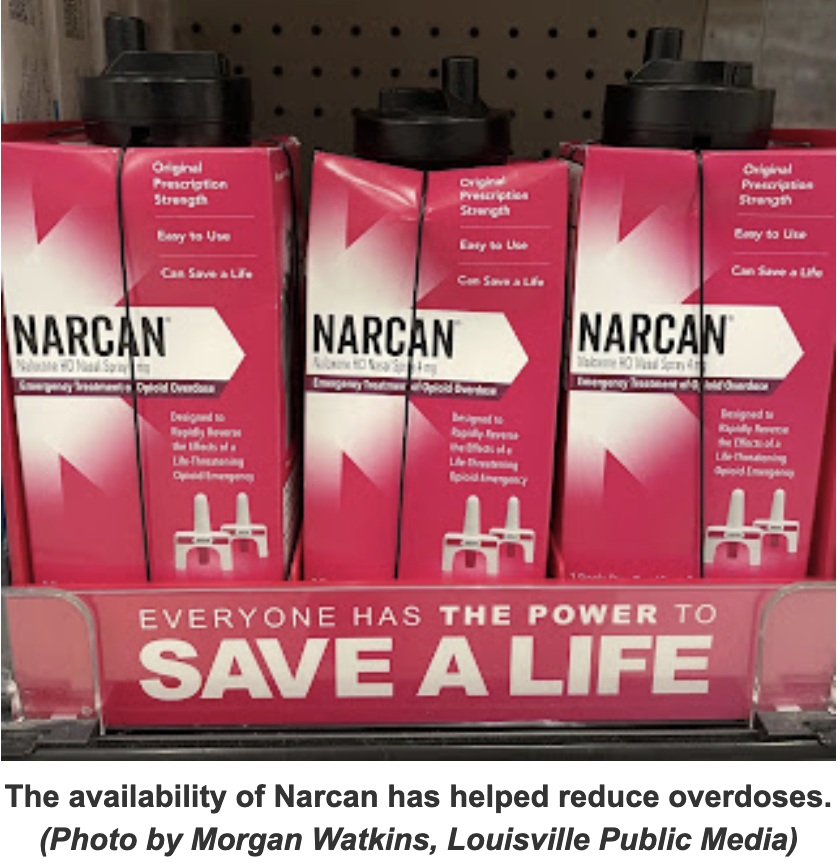Fewer dying from overdoses, but advocates say Kentucky needs more people mentoring others through addiction and recovery

By Sylvia Goodman
Louisville Public Media
Shawn Nutter walks through The Healing Place’s men’s facility in Louisville’s Russell neighborhood. He just completed the months-long recovery program, and now, Nutter’s working as a peer mentor for other people going through the same thing.
“You get six guys to get to intimately know, so you get to really understand what’s going on with them,” Nutter said as he wound through the facility. “The things that could possibly help them or maybe hindered them in this process.”
He says he feels like he’s found his calling. Before coming to the Healing Place, Nutter said he worked as a chef, but now he wants to get certified as a peer support specialist.
“I want to know everybody that comes through here just because I like to know people,” Nutter said.
It’s a specialization sorely needed in the state. Earlier this month, Kentucky’s Office of Drug Control Policy released its annual report on fatal overdoses. For the second year in a row, overdose deaths went down (9.8 percent, more than triple the national decrease of 3%) but remain well above the levels the state saw before a 2020 spike rocked Kentucky.
And the numbers aren’t down across the board. Deaths continue to rise among Black Kentuckians, who have yet to see a decline since 2020. In 2018, 77 Black Kentuckians died of fatal overdoses, according to the report. Last year, 264 Black people in Kentucky did.
Gov. Andy Beshear declared the secind reduction in a row a win for the state while acknowledging there is more left to do. “We still have a long way to go, but celebrating success, celebrating doing better, celebrating having a better year is what gives us the strength to do even more,” he said.
Tara Hyde, CEO of Louisville’s People Advocating Recovery, attributed the spike to the isolation of the pandemic and a drug supply heavily saturated with the powerful synthetic opioid fentanyl. “The fact remains that thousands of people have still lost their lives,” she said. “Thousands of families have been impacted.”
Hyde says advocates and service providers in the state know the work is far from over, especially in Black and Brown communities across the state. “We still are hesitant to really create more recovery supported spaces I think that’s the re-energizing of saying, ‘I know that these systems are working, we just need to keep moving in that direction’.”
Improving outcomes for those in treatment
Recovery-supported housing, community centers and employment centers are popping up around the state to aid people as they leave treatment. Hyde said there are many examples across the state that her group has helped to foster, but services aren’t always centered in the communities that need them most.
Sharon Walsh, the director of the University of Kentucky’s Center on Drug and Alcohol Research, largely credits the decline in deaths to the much more widespread availability of the overdose-reversing drug naloxone, branded Narcan, which Walsh called a “miracle drug.”
Walsh said the 2020 spike in Kentucky was horrific and she can’t imagine how bad it would have been without the availability of naloxone, but she says there’s still work to be done the day after someone survives an overdose.
“You pick [naloxone] up at a fair, and then you have it in your pocket, and maybe you get to use it,” Walsh said. “That’s incredible that you get to save someone’s life. Does it make a longer term difference for that person whose life you saved? That’s where the critical importance of linkage and education comes in.”
It’s an emphasis on those post-treatment spaces that could lead to declines in overall overdose numbers, Walsh said. She also emphasized the importance of working directly in the most impacted communities.
“People want to go to providers that look like them,” Walsh said. “If there aren’t any providers that look like them, then that is also another barrier.”
A lot stands in people’s way of accessing that care, Walsh said. In rural communities, the closest treatment center can be hours away, or in majority Black areas with historic under-investment, medical care in general is often difficult to access.
“There’s some very innovative programs going on with our colleagues out in Jefferson County that really can serve as models for other people to do, but they definitely need to be scaled up,” Walsh said.
There are several organizations in Kentucky that have boots on the ground going in to provide harm reduction and education to people directly — things like naloxone, fentanyl testing strips and hygiene supplies.
Abbie Kent is on the street team of the New Day Recovery Center in Winchester. She travels across the state, from urban areas to tent camps in rural Kentucky forests. Kent said the fact that she lived through to recovery and is able to provide resources to people breaks down barriers.
“They see me with a two-year-old track mark,” she said. “I was an IV drug user for the better part of 20 years, and my arm shows that when I come to people. They realize I’m not just some clinician.”
Kent said she is out there every day for people, going into overdose hotspots without judgment. “It’s not about evangelizing, it’s about planting the seed with people, and then making sure they have the resources to turn around and help somebody else,” she said, adding that she is able to build that trust only by being in those spaces and making herself a part of the community. Then when people need help, they know whom to ask.
Kentucky Health News is an independent news service of the Institute for Rural Journalism and Community Issues, based in the School of Journalism and Media at the University of Kentucky, with support from the Foundation for a Healthy Kentucky.
Donate to Kentucky Health News here.